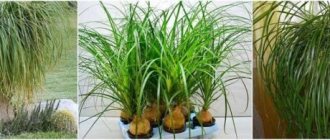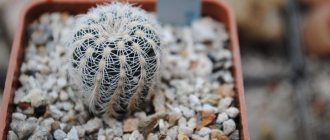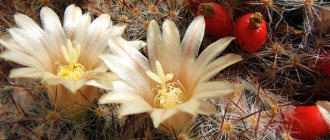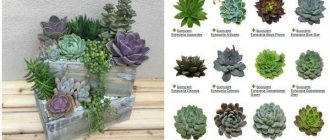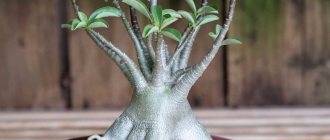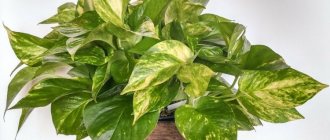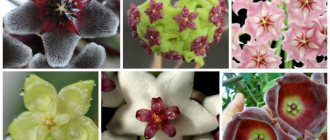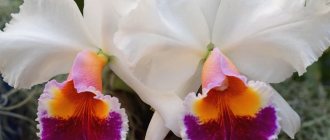Echinocacti are one of the most popular plants from the Cactus family, which are found on the windowsills of gardeners. Unpretentious, slow-growing exotics easily tolerate the mistakes of beginners. Therefore, growing a beautiful echinocactus is quite simple. The name of the genus translates as “hedgehog cactus,” and indeed the plants are very similar to hedgehogs curled into a ball.
In Mexico and the western part of the American continent, local residents use some varieties for cooking. Echinocacti also have medicinal properties. Uncontrolled collection of plants for one's own needs led to a sharp decline in the population, so local authorities introduced a ban on collecting wild crops. To enjoy an unusual dish, you need to go to a special nursery where cultivated plants are grown.
How to care for this species at home?
Temperature
In spring and summer, the most optimal temperature is -20 – 25 °C. An increase in temperature is undesirable, the flower overheats, begins to fade, and the growth and development of the flower slows down. In autumn, the air temperature should gradually decrease to 10 – 15 °C.
Watering
Watering is moderate, like all succulents, the echinocactus Gruzoni red does not tolerate dampness and excessive moisture. In spring and summer, watering should be done once every 10-12 days. In extreme heat, it is recommended to lightly spray the stem to reduce the temperature. Spraying clears dust and refreshes the flower. In autumn, watering is reduced.
Important! The soil should dry out well between waterings. It is better to water through a tray or by immersion
After watering, water must be drained from the pan immediately; getting the roots wet is unacceptable.
Light
The variety is not afraid of direct sunlight. It is better to install pots on the south, south-east side of the house. After wintering, the plant is gradually accustomed to direct sunlight. Due to lack of light, the stem becomes deformed, wrinkles, grows one-sidedly, and can shed its thorns. Rotate the pots clockwise periodically to ensure even light exposure.
Priming
The soil should be light, loose, enriched with minerals, slightly acidic.
Small stones, gravel, and red brick chips are used as drainage. Composition of the soil mixture:
- Leaf soil - 1 tsp.
- Turf soil – 2 hours.
- Coarse river sand – 1 tsp.
- Peat – 1 hour.
- Drainage.
To prevent fungal diseases, it is recommended to add crushed charcoal to the soil.
Trimming
This species does not need special shaping pruning. In case of stem disease or root rotting, the plant requires urgent help:
- Carefully remove the flower from the pot.
- Rotten roots are cut off completely.
- The trunk is cut on all sides, wedge-shaped, around the entire circumference.
- The sections are powdered with crushed activated charcoal or charcoal.
- The turned barrel is installed vertically in a dry transparent glass.
- The lighting is bright, watering stops.
New roots appear within a month.
Feeding
They begin to fertilize the flower after wintering. Feeding continues until the end of summer. It is necessary to use special liquid fertilizers for cacti. Fertilizers must contain microelements - chelates. Nitrogen fertilizers are applied only at the very beginning of spring.
To stimulate flowering, they are fertilized with potassium-phosphorus fertilizers (“Hylea for cacti and succulents”) To feed the root system, concentrated fertilizers with magnesium and other microelements are used. Organic fertilizers are contraindicated. In autumn, fertilizing is reduced.
Pot
The diameter of the pot should be 1-1.5 cm larger than the stem itself. The pot or container should not be too deep - the substrate will retain excess moisture. It is better to use ceramic containers; they do not overheat in the bright sun and allow air to pass through well. Holes must be made at the bottom of the pot to allow water to drain.
Transfer
The plant needs replanting every 3 years, even if the flower has not outgrown the size of the container. When replanting, the soil completely changes.
Due to the dense thorns, difficulties arise with the transplantation procedure. It is necessary to use thick gloves or a special wire loop - grip
The loop is carefully placed between the spines so as not to break them. The soil should be steamed or baked in the oven for disinfection before planting.
It is recommended to transplant in early spring. Transplant procedure:
- Using a loop, the flower is carefully removed from the pot.
- Dry and rotten root shoots are cut out.
- The cut areas are treated with crushed coal.
- It is necessary to keep the flower for 2 days for the cut roots to heal.
- The plant is transferred, the roots are buried.
- Watering - through a tray 4 days after transplantation.
Important! After 2 weeks, it is necessary to feed the flower through watering. In order for the transplanted echinocactus to grow straight, without distortion, it is important to place it evenly in the new pot
In order for the transplanted echinocactus to grow straight, without distortion, it is important to place it evenly in the new pot
Wintering
The winter temperature of the flower is 9 – 11°C. Additional air humidification is not required; watering stops.
The lower the air temperature, the less moisture the plant requires. From hypothermia, brown spots appear on the stem, and there is a risk of fungal infection.
To avoid freezing of the roots, the pots are placed on wooden stands. There is no need to feed the plant in winter. The lighting is bright. It is necessary to illuminate the plants with special lamps for 2–3 hours a day.
You will find more information about general care of echinocactus here.
Rules of care
Echinocacti are unpretentious plants, so caring for them is quite easy. It is enough to follow the watering norms and provide the plant with bright light and warmth.
Lighting
Echinocactus is a heat-loving and light-loving plant. Exotics are not afraid of direct sunlight; on the contrary, being in a well-lit window, cacti grow and develop well. In summer, pots should be placed on southern, south-eastern and south-western window sills.
In summer, flower growers advise placing pots on the balcony, veranda or garden. For echinocacti, a well-lit place is suitable, where the shadow of large crops will not fall.
If the cactus does not have enough light, it will stretch out, become faded and lifeless. The spines will become thin and brittle.
In winter, light is just as important for a plant as in summer, so it is recommended to supplement the cacti with special lamps. If the cactus was in the shade or under a lamp during the winter holidays, then it needs to be gradually accustomed to the bright sun.
Question to the expert
Echinocactus grows on one side, could this be due to lighting?
Yes, the plant develops one-sidedly due to improper distribution of sunlight. In order for the cactus to develop evenly, it must be turned once every two weeks with its other side facing the light source.
Temperature
In summer and spring, echinocacti grow well at temperatures from + 18 to +26 ° C. In extreme heat from +30 °C, plants are stunted in growth and “fall asleep.”
In winter, during the dormant period, the temperature should be maintained in the range from +10 to +13 °C. If the temperature is lower, the plant will freeze and may die.
Watering mode
The cactus is able to accumulate water in its stem, so short periods of drought are not a problem for it. It is much worse if the plant is watered regularly and abundantly. Stagnation of moisture at the roots can lead to the development of rot and stem.
Water echinocacti with settled, filtered or bottled water at room temperature. Use watering cans with a narrow spout so that water does not fall on the stems and flowers of the plant. In spring, watering is carried out with water heated to 30 °C, this helps the plant wake up from winter sleep.
The watering interval is calculated based on growing conditions and time of year. On average, watering in summer and spring is carried out once every 1.5 weeks. In winter, about once every 30 days. Excess water must be drained 15–30 minutes after watering.
Question to the expert
Do I need to spray a cactus?
There is no need to additionally spray echinocacti. Water procedures are rarely carried out just to remove dust from the plant.
Fertilizer and feeding
During the growing season, plants are fed with complex ready-made fertilizers for cacti and succulents. Feeding is carried out no more than once a month.
It must be remembered that an excess of nutrients is much worse than a slight deficiency.
It is important to know that cacti do not tolerate organic fertilizers, as well as compounds with a high concentration of nitrogen.
Bloom
Echinocacti begin to bloom at the age of 10 to 20 years. Young plants do not bloom. The flowering period occurs in early spring or summer. Depending on the type of cactus, the cactus grows a peduncle or many small buds in the center of the plant.
The peduncle grows from a bud on the top of the stem. A large bud, yellow, white or pink, is formed on it. The outer part of the petals is covered with short hairs. The petals are very thin and glossy. Depending on the type of cactus, the size of the buds can be from 10 to 50 mm.
Types of echinocacti with photos and names
Most often, it is the echinocactus Gruzoni that is grown at home. The remaining species differ in appearance from it in the color of the flowers and spines, as well as in the number of ribs. It is the number of ribs that is considered the best guide when determining the type of echinocactus.
Echinocactus grusonii
Or Echinocactus Gruzon, Gruson. This species has rounded stems and light-colored needles. As it grows, Echinocactus grusonii acquires a barrel-shaped shape and is distinguished by numerous ribs. Their number is at least 35 pieces.
When choosing such a cactus in a store, you should remember that its spines can only be colored in shades of white or light yellow. Specimens with bright needles were obtained by adding special dyes to the soil to achieve a more decorative effect. Some time after purchase, the needles of such a plant should acquire their natural color. Usually, food dyes are used to obtain exotic colors, but if the paints still contained substances harmful to the cactus, it may begin to hurt. In addition, when dyes get into the stem, they can impede the production of chlorophyll. To be more likely to buy a healthy cactus, it is better to avoid such multicolors, choosing a more modest natural version of the plant. If a painted cactus has already been purchased, it is cared for like an ordinary one. But you can try to remove some of the paint by carefully wiping the surface of the stem with a cotton swab dipped in warm water.
Echinocactus platyacanthus
Or a broad-spined, huge echinocactus. Mexican species up to 2 m tall. Echinocactus platyacanthus (ingens) grows up to 1.5 m in width. No more than 25 ribs are formed on its stems. They contain areoles, complemented by wide gray needles with dark strokes. Their length can be from 3.5 to 4.5 cm. During the flowering period, yellow tubular flowers appear on the stems. Unlike the Echinocactus Gruzon, at home this species often pleases with its flowering.
Echinocactus parryi
A miniature species, the height of which even in nature reaches only 30 cm. Echinocactus parryi has from 13 to 15 ribs. Over time, its spherical shoots begin to take on the shape of a cylinder. The stem of this cactus is colored blue-gray. The remarkableness of the species is not only in its size, but also in the length of the spines. It can reach 10 cm. Young needles are painted in a bright pinkish-brown color, but then lighten. Domestic specimens do not tolerate waterlogged soil well, so they should be protected from the development of rot.
Horizontal Echinocactus (Echinocactus horizonthalonius)
The remarkableness of this species is reflected in its name. The stems of Echinocactus horizonthalonius do not stretch upward as they grow, but acquire a flattened shape. They have from 10 to 13 ribs in a spiral arrangement. Each areola includes up to 6 curved spines. They have a reddish color, gradually changing to amber. The flowers have a lilac-red hue.
Texas Echinocactus (Echinocactus texensis)
A medium-sized multi-ribbed species up to 20 cm high with a stem width of about 30 cm. Echinocactus texensis lives in grass. The color of the stem can vary from green to gray-green. The needles are colored brownish, gray or pink, with the radial spines bent downwards. The flowers have a silver-pink color and a reddish throat and appear on bushes 10 cm wide.
Echinocactus polycephalus
At home, this type of echinocactus grows up to 70 cm. Echinocactus polycephalus has colored spines, painted red-brown, pink or yellow. The number of ribs ranges from 15 to 20 pieces.
Cacti and Succulents Indoor Plants
Growing conditions
Lighting
The desert conditions of the natural habitat rewarded the echinocactus with resilience. Feel free to grow it in a south-facing window. After winter rest, it is advisable to shade the plant (lean a sheet of paper against the glass or leave the blinds half-closed) so that the seasonal increase in light intensity passes painlessly.
Air temperature
Tolerant of spring and summer room temperatures. It is recommended to take it out into the fresh air during the warm season - a veranda, an open balcony, while daily temperature fluctuations are absolutely harmless. As with most cacti, a cool winter at 10-12 °C is preferable; do not allow the temperature to drop below 8 °C.
Description and characteristics
The stem of the cactus with colored needles is spherical in shape, but over the years it becomes barrel-shaped. An adult plant is very large both in height and in width. It does not bush, if the growing conditions are favorable, then the children do not appear.
Blooms in late spring early summer. Flowers appear only on those cacti that are more than 20 years old, and the stem is forty centimeters wide. Single yellow flowers can be up to seven centimeters in length. They are on the top of the cap like a wreath.
Botanical portrait
In indoor conditions, the Gruzoni echinocactus (Echinocactus grusonii) grows no more than 40 cm in diameter. It rarely branches, except as a result of damage to the stem. Children formed on the plant most likely indicate some kind of dysfunctional process with it. It is advisable to use them for rooting, so as not to completely lose the flower.
The stem is bright green, consists of 30-40 ribs, densely covered with strong yellow spines, although there are alba forms with white needles. Each areola usually contains 1-4 central needles and up to 10 radial needles directed in all directions. The top of the ball seems to be dotted with yellow fluffs - this impression is created due to the formation of young areolas.
Flowering in indoor cultivation rarely occurs, only at a much mature age. The flowers are small, short-tubular, arranged in a ring around the crown of the ball, the petals are narrow, light yellow.
On sale there are forms of Echinocactus Gruzoni E. grusonii f. alba and E. grusonii f. curvispinus.
General information
Help: In nature, there are no echinocacti with red or green spines. You need to know that in this case the plant was grown using dyes to obtain this color of the spines.
You don’t see Echinocactus blooming very often. For it to bloom, the echinocactus must be at least twenty years old, and the diameter of its stem must be at least forty centimeters. Flowers can be yellow, red or pink. They appear at the top of the plant, the petals of the flower are narrow and drooping.
Rainbow cactus - marketing ploy with coloring
On the shelves of flower shops, balls of Echinocactus Gruzoni are often displayed in bright red, blue, orange and yellow shades called “rainbow cactus”. Echinocactus Gruzoni does not have such natural colors; plants are colored for sale - at best, with food coloring. They simply remain on the finger when rubbed across the surface of the cactus. Much worse for a plant colored with printer ink. It can be seriously injured or even killed. Money spent on buying a beautiful cactus will be wasted.
A similar marketing ploy is used when selling the so-called echinocacti Gruzoni Red (red) or Rainbow, only the plants have colored spines, the stem remains green. The needles are the more durable part of the cactus, and the cactus itself, as a rule, does not suffer from such a modification; only over time the color disappears, and the spines again acquire their natural yellowish appearance.
Features of choice when purchasing
There are a large number of species of Echinocactus on sale.
In reality, such varieties of cactus do not exist; the spines are simply painted in the appropriate colors with food dyes - respectively, red or several bright shades at once
You can buy such cacti with virtually no fear, because caring for the red echinocactus gruzoni or Rainbow costs the same as for a regular one, you just need to pay attention to the fact that dyes can negatively affect the plant, so if possible you should try to wash them off
A few words about the “colored” varieties of Echinocactus Gruzon
Under natural conditions, this type of cacti has two types of needle colors - yellow or reddish. There are many ornamental varieties of Echinocactus gruzon, such as purple, pink, red or rainbow. This coloring of needles can be achieved either by modifying genes or adding food coloring to the water for watering the flower.
Food colors are harmless to plants as they are non-toxic. At home, it takes quite a long time to water with such colored water.
Remember that such watering must be carried out for at least six months. The larger the plant, the longer it will take to water it with this water.
To make your pets look original, it is better to choose fairly bright dye colors. By mixing dyes of different colors, you can achieve unique shades of Echinocactus Gruzon needles.
How to properly transplant echinocactus Gruzoni after purchase
Echinocactus Gruzoni recovers from transplantation as if from a long illness. Therefore, slow growth is a significant plus. Young specimens are replanted once every two years; adults only need one procedure every 3–4 years. The best time for this is mid-spring.
The plant does not need a large pot. It is enough to increase its diameter by 1–2 cm each time. Choose a shallow container, similar to a bowl or salad bowl - the root system of the Echinocactus Gruzoni is superficial. Ceramic is preferable among materials - it allows air to pass through better.
A deep volume pot is not suitable for Echinocactus Gruzoni - the root system of the plant is superficial
A special soil for cacti and succulents, which can be purchased without any problems at the appropriate store, is quite suitable for growing the Gruzoni echinocactus. Another option is to mix the substrate yourself. The soil should be light, slightly acidic (pH 5.5–6) and not too nutritious:
- coarse river sand, universal soil for decorative foliage indoor plants, small pebbles or crushed stone (1:1:1);
- turf and leaf soil, sand, small pieces of charcoal (4:2:2:1);
- crushed pumice, leaf soil, perlite or vermiculite (1:1:2).
It is useful to add crushed chalk or powdered activated charcoal to any substrate (1–2% of the total volume of the mixture). This will help prevent the development of root rot.
Special soil for cacti and succulents will suit the echinocactus Gruzoni
There is nothing complicated about the transplant itself:
- Fill the new pot with expanded clay about 0.3 cm in diameter or fine chips from red bricks. The older they are, the better. The thickness of the drainage layer is at least 3–4 cm. On top is 1–2 cm of freshly prepared disinfected substrate.
- Remove the plant from the pot, being careful to disturb the roots as little as possible. They are very fragile in the Echinocactus Gruzoni. Since, unlike the roots, its thorns are by no means thin, even thick gloves, thick fabric, newspapers, and other improvised means will not save you from minor abrasions and scratches. Experienced cactus growers recommend twisting a loop of strong wire with a long “handle.” They put it on the ball, fixing it approximately in the middle, trying not to break the needles. After this, the pot can be turned upside down and, gently tapping, remove the plant.
- Examine the earthen lump. If rotting, blackened, dried roots are visible, cut them off with a sharp, disinfected knife. Sprinkle the “wounds” with crushed chalk, activated carbon, cinnamon, or treat with iodine or brilliant green.
- Allow the roots to dry out for 2-3 days in the open air to allow the inevitable microdamage to heal. The larger the plant, the longer it will take.
- Place the echinocactus in a new pot. Add soil around the edges. Be careful not to bury the base of the stem.
- Place the plant in light partial shade for about a week. Provide warmth (about 25ºC). The first watering is no earlier than 3-4 days after transplantation.
The main difficulty in transplanting Echinocactus Gruzoni is to remove the plant from the pot with minimal damage to itself and it.
Landing
Even an unprepared beginner can handle planting and transplanting echinocacti. The main thing is to be consistent and act carefully.
And also take into account the composition of the soil and the size of the old and new pot.
Choosing a pot
Wide but shallow containers are suitable for planting echinocactus. The diameter of the new pot should exceed the old one by only a few centimeters. A pot that is too spacious can cause the death of the plant.
Any material is suitable, but ceramic must be glazed. In an uncoated pot, moisture evaporates through the porous walls and cools the root, and cacti react extremely negatively to low temperatures at the roots.
For large specimens, experienced gardeners advise choosing stable pots so that the plant does not fall on its side. There should be drainage holes at the bottom of the container.
When calculating the height of a new pot, it is necessary to take into account that you will have to add a little root collar and take a container with a margin of about 2 cm.
Soil composition
Neutral, loose soil mixtures are suitable for echinocacti. You can use ready-made soil for cacti and succulents or mix the soil yourself.
Soil composition (1:2:2:4):
- small pebbles, gravel or brick chips;
- coarse river sand;
- leaf soil;
- turf land;
- crushed coal.
A drainage layer of fine expanded clay or gravel must be poured onto the bottom.
Echinocactus types photos and names
Echinocactus gruzoni lives specifically in Mexico, where its size significantly exceeds the prickly balls with a diameter of 40-45 cm that are typical for home furnishings. The spines are either straight or slightly curved, have quite high strength, and are oblong.
It is precisely in connection with the latter property that the entire family as a whole began to be called “hedgehog cacti” and, by the way, this is not their only unofficial name. The fact is that this species, after 13-14 years of development, changes its shape from spherical to barrel-shaped with dimensions up to 1.2-1.5 meters in height and up to 0.9-1 meter in width, thus from a “hedgehog cactus” turning into a “golden barrel”.
The color of the spines includes pale yellow and, less often, white tones, which should be taken into account before purchasing this cactus, since the store-bought echinocactus gruzoni contains various additives in its name, such as “red” or “rainbow” (echinocactus red and echinocactus rainbow, respectively ), in fact, is not a separate variety, as you might think at first, but is just painted a different color with ordinary food coloring, or maybe, what is much worse, with a dye from a printer.
It is better to avoid such “colored hedgehogs”, because, although with age they will clear themselves of foreign impurities (returning the spines to a natural yellowish tint), but while this happens, the owner may encounter serious problems when growing, which should not have happened basically.
Echinocactus planosumata
Slightly less popular, it is slightly taller - 1.5-2 meters - and wider - 1-1.5 meters, has much fewer ribs - no more than 20-25. The grayish spines are straight in shape. Due to its taste, the species almost ended up on the endangered list in Mexico, where it has become an integral component of culinary sweets.
Echinocactus parry is the same spherical at the beginning of growth, then it acquires a cylindrical shape. This beauty from the north of Mexico has a relatively small height - 30-35 cm and curved brown-pink spines, which turn white over time. This species has very high care requirements associated with poor seed germination and susceptibility to various diseases at a young age.
Echinocactus horizontalis is somewhat different from its “brothers” in its shape, and specifically in its flattened spherical outline with 11-12 spirally twisted ribs. Even adult representatives of the species are characterized by a relatively small diameter of 25-30 cm and slightly thickened curved spines of a rich red color.
Unlike other types of Echinocactus flowering, horizontal flowering is easy to achieve at home (its beautiful flowers are up to 3 cm long and lilac-red in color), following basic care rules.
Echinocactus broad-spined is notable for its myriad of spines, up to 3 cm long, brown in color. At the same time, the dimensions of the aged specimen are 150x125 cm in height and diameter. During the flowering period, yellow funnel-shaped flowers appear.
Echinocactus polycephalus actually has multi-colored needles - yellow, brown-red or pink. When forced into an apartment, it can grow up to 70 cm in height with 15-20 ribs and a small number of spines.
Echinocactus polycephalus is similar in both size and number of ribs to the previous species. At the same time, its spherical shape with bristling spines, to the greatest extent among all echinocacti, claims to be compared with a real hedgehog. Prefers to be part of a large group, which can include up to 100 plants!
Features of transplantation
Hedgehog cactus is replanted in the spring at the beginning of a new period of active growth. The frequency of replanting young plants is 2 years, adults - 3-4 years.
Take the container a little larger each time, adding 1 cm in width and height. Line the bottom of the pot with drainage (expanded clay, broken brick, pebbles, pieces of polystyrene foam or a mixture of them) up to ¼ of the total volume. The soil required is moderately nutritious, permeable to water and air, slightly acidic (pH = 5.5). Take a universal substrate for succulents as a basis, add a little leaf humus and coarse sand. Another option: an equal ratio of turf soil, river sand and expanded clay.
The spines are sharp, be sure to wear thick gloves. Tapping on the walls of the pot, carefully remove the plant along with the earthen lump. The root system should not be disturbed; transfer it entirely. For more convenient transfer of the plant, the stem is wrapped in a “belt” of newspapers or a holder is made from wire (it must be passed between the needles).
Add the missing amount of soil, water and slightly press the soil at the surface.
Flowering of horizontal and wide-needle echinocactus (with photo)
Echinocactus is the oldest genus of the Cactaceae family, which includes about 10 species of large spherical cacti. Literally translated as “hedgehog cactus”; amateurs call them barrel cacti. Their sizes are large; the echinocactus Gruzoni (E. grusonii) is the most common in culture.
Look at the photo - the stems of echinocacti are spherical, very large, light green in color:
Pronounced ribs (about 30) are armed with golden-yellow spines (up to 5 cm). The spines are translucent, hard, curved. In nature, it is almost completely destroyed, but is widespread in indoor culture. This golden ball can grow up to 1.3 m in height and up to 1 m in diameter, although specimens over 100 years old reach such sizes. Yellow flowers up to 4 cm in diameter appear in the summer at the top of the plant in the form of a ring.
Pay attention to the photo - flowering of echinocactus occurs only when it reaches 3-4 years of age:
Horizontal Echinocactus (Echinocactus horizonthalonius Lem.). One of the smallest echinocacti: its maximum height is 25 cm. There are 8 ribs. The spines are red when young, later yellow; up to 4 cm in length. Flowers are different shades of red.
Echinocactus platyacanthus Link & Otto; . View from Mexico. The plant is up to 150 cm high and up to 125 cm wide, with a heavily pubescent top. There are more than 50 ribs. The spines are brown, up to 3 cm in length. The flowers are yellow, funnel-shaped, 2 cm long.
Echinocactus polycephalos Engelm. & JMBigelow - Echinocactus multicapita. View from the Mojave Desert (USA).
By cutting down a barrel-sized echinocactus from the prickly pear family, the traveler received moisture for himself and succulent food for his horse. Interestingly, in these places, mules and donkeys have perfectly adapted to independently knock off cactus spines with their hooves in order to enjoy the tasty stem and its juice without interference.
Even wine is made from echinocactus. The famous Mexican red wine, not strong, only twelve degrees, but sweet. It has only two drawbacks: it cannot be stored for more than two weeks and cannot be transported over long distances.
Echinocactus gruzoni is red as it blooms. Description
Echinocactus belongs to the cactus family. It grows naturally in the desert areas of Mexico and the Southwestern United States. Echinocactus Gruzoni is the most common species both in nature and in indoor floriculture. The locals call this perennial, slow-growing plant “hedgehog cactus.” Indeed, echinocactus resembles a hedgehog in its shape and spines. The name Echinocactus was named after Hermann Gruzoni, a German inventor and collector of these prickly plants.
Echinocactus grows to very large sizes in the wild
Echinocactus Gruzoni in natural conditions grows to gigantic sizes, reaching a height of up to one and a half meters and a width of up to a meter. The cactus is a long-livers, growing up to 200-500 years. As the plant grows, it changes from a ball shape to a barrel. Therefore, its second name is “golden barrel”. It should be noted that as they grow older, the appearance of the echinocactus changes. After three to four years, the small tubercles become sharp ribs covered with dense, sharp spines. The growing upper part is first covered with “fluff” - young, not yet hardened spines.
So, the echinocactus Gruzoni is a spherical stem covered with sharp ribs located vertically. The number of ribs ranges from thirty-five to forty-five. The surface of the stem is glossy and green. On the ribs there are areoles, from which spines grow in a bunch. Each areola contains radial spines (about ten) and central spines (from one to four). The length of the spines is from three to five centimeters. The central spines are longer than the radial ones. On the growing top, a “hat” of young spines resembling fluff looks beautiful. The color of the spines varies from white to yellowish.
Attention! In nature, there are no Gruzoni echinocacti with red, green, or bright yellow spines. Such specimens are grown for sale using dyes
In the best case, the plant will acquire its natural color over time. And if you use harmful paints, the cactus begins to hurt and may die.
In indoor conditions, echinocactus grows up to 40-60 centimeters in height and 40 in diameter. But to reach such a size, it will take more than a dozen years.
Blooming Echinocactus Gruzoni
Waiting for flowering will also be difficult, because they bloom after twenty years. The cactus blooms in May-June. First, a bud appears at the top, on a long stalk, from which a yellow flower blooms. The flower tube is funnel-shaped, pubescent on the outside. The petals are thin and glossy. Closer to the edge of the petals, their color becomes darker, acquiring a brown tint. The corolla of the flower reaches 7 cm in length and 5 cm in diameter.
Description
Most echinocacti are spherical in shape, but sometimes the plants stretch upward or grow sideways. In the natural environment there are specimens from 1 cm to 3 meters in height, from 1 cm to 2 meters in diameter. But at home, echinocacti usually do not grow more than 60 cm in height with a diameter of 40 to 60 cm. Echinocacti are slow-growing crops that can live from 200 to 500 years in good conditions.
The stem of the plant is dark green, light green or grayish green. The spines can be yellow, white, reddish, with a brown and reddish tint, and also have zonal paint.
Until the age of five, the stem of Echinocactus is covered with small tubercles, which subsequently become more pronounced. The number of ribs on one specimen is from 5 to 50. Along the upper edge of the ribs are areoles, from which needles grow.
From one areola 4 central spines and several radial spines can grow. On the top of the cactus there is a characteristic “cannon” of fragile spines. The length of the spines, depending on the type and age of the plant, can vary from 1 mm to 6 cm.
At home, cacti bloom quite rarely, but with good care they can please gardeners with unusual buds. Cacti first form buds between the ages of 10 and 20 years. A flower bud forms on the ribs, from which a peduncle grows.
In some varieties, flower buds grow directly in the center, one at a time, or are arranged in circles, forming a wreath of buds.
Guseva Ulyana
Ask a Question
Question to the expert
Do echinocacti with colored spines exist in nature?
In their natural environment, cacti grow with yellow, reddish, and white spines. Bright yellow, green, scarlet and light green needles are a special paint. Some time after purchase, the specimen with colored spines will acquire its natural color.
Description of Echinocactus Gruzoni
The stem is spherical, but over the years it looks more like a barrel. The cactus can reach a meter in height and width.
It does not form bushes, and children do not separate from it. Even if the conditions are favorable. Therefore, Echinocactus Gruzoni grows alone. However, sometimes small families consisting of a pair of such “barrels” can be found.
The stem is glossy and dark green in color. Larger representatives may have 30 to 40 ribs on the stem. Fluffy areolas are scattered on them.
The areoles at the top of the cactus form a small yellow cap. This color is provided by yellowish spines.
Their length reaches five cm. The bright color of the spines makes them stand out against the dark background of the stem. It is because of this contrast that Echinocactus is called the “Golden Ball”.
Growing conditions
Illumination
Unlike many other cacti, Echinocactus needs to be kept in light all year round. He is not afraid of direct sunlight. Therefore, it is better to place the cactus on the windowsill of a south window. In summer, it is recommended to take the plant outside. For example, not a balcony or a garden.
With a lack of light, the cactus will gradually die. First, the thorns will begin to fall off, and then the stem itself will wither.
Temperature
It is better to avoid hot places. At temperatures above 30 degrees, the growth and development of the plant deteriorates. The cactus goes into a premature state of dormancy, which can have a bad effect on its future existence.
Between October and the end of February, the cactus enters a natural state of dormancy. During this time, you need to provide a room with a low temperature (about 12 degrees). If the temperature is lower, the cactus will freeze and its appearance will suffer significantly.
Humidity
The air humidity in the apartment is suitable for growing. It does not need spraying. Sometimes you can take a warm shower.
Earth mixture
Neutral and mineral soil is ideal
It is important that it allows air and water to pass through well. If you intend to use a factory mixture, then add a little brick chips or small pebbles to it
You can also add some charcoal. It will protect the plant from rot. Don't forget the substrate. You can mix it yourself.
Rules of care
How to water Echinocactus Gruzoni
- For Echinocactus Gruzoni, watering is not so important, so its frequency can be minimized.
- Before watering again, make sure the substrate in the pot is completely dry. Water must be infused and at room temperature.
- Avoid overwatering as this can cause rot.
- In winter it is better to refuse watering.
Top dressing
Feeding is necessary during active growth. About once a month. Use factory-made fertilizers intended for cacti or succulents. During the dormant period, it is strictly forbidden to apply fertilizers to the soil.
How to transplant Echinocactus Gruzoni
Flower growers do not recommend replanting it. This is due to the fact that its roots are very sensitive, and its needles are very hard and sharp. If there is a need for a transplant, then this should be done very carefully.
Experienced gardeners recommend moving the cactus itself using a wire loop. This way you won't get hurt or damage the roots.
Reproduction of echinocactus gruzoni at home
In most cases, seeds are used for propagation. However, reproduction by children is also possible. But the second option is used very rarely, since children are not often formed on mother plants.
Brief rules for growing echinocactus
The table provides brief rules for caring for echinocactus at home.
| Lighting level | Plants prefer bright light, so they should be kept in south-facing windows. |
| Content temperature | In spring and summer, echinocacti prefer warmth - about 25 degrees. In winter, the plant prefers coolness, but the temperature should not be lower than 8-10 degrees. |
| Watering mode | In spring and summer, the soil is moistened only after it has completely dried. If the plant overwinters in a cool place, it is not watered at all. |
| Air humidity | The cactus does not need high humidity. |
| The soil | For growing echinocactus, a neutral or slightly acidic substrate in which moisture does not stagnate is suitable. |
| Feeding | From spring to late summer, you can fertilize the bushes with special compounds for cacti, containing a minimum of nitrogen additives. |
| Transfer | Growing echinocacti are replanted annually or once every couple of years - at the end of February. |
| Bloom | The period of appearance of flowers occurs at the end of spring. |
| Rest period | In winter, echinocacti go into retirement. |
| Reproduction | Seeds, kids. |
| Pests | Scale insects, scale insects, cactus mites. |
| Diseases | Root rot due to overwatering. |
Cactus Echinocactus Gruzoni care at home. Transplantation of Echinocactus Gruzoni
The plant does not like too frequent transplants. Any, even slight mechanical damage to the root system is very painful. That is why they try not to disturb the flower again with transplants. The only exceptions are situations when the echinocactus Gruzoni has become cramped in the flower container or the roots have rotted.
After purchasing the flower, they are quarantined for 2-4 weeks. It is necessary both for the plant to get used to the microclimate of the new room, and for the grower to make sure that the cactus that has just arrived at the house is free of diseases and pests.
Choosing a flower container
The pot for the cactus is selected to be low - its root system is located in the surface layer of the earthen clod. The diameter of the vessel should exceed the circumference of the echinocactus ball by 1-2 cm.
The material of the pot does not play a very big role, but if you have a choice, it is better to go with earthenware. There is less risk of rotting of the root system, since the evaporation of moisture from the soil mixture occurs more intensely.
There must be a sufficient number of drainage holes at the bottom of the pot for the timely drainage of excess irrigation water.
Attention! During transplantation, you should not forget about the traumatic needles of the plant. It is necessary to move the echinocactus from one pot to another using a wire loop or a thick towel folded in several layers, so as not to prick the skin on your hands and fingers.
Soil preparation
The plant is successfully grown using ready-made soil mixtures called “For cacti and succulents,” purchased at a flower shop. A self-prepared soil mixture includes the following components:
- 1 part leaf humus;
- ½ part coarse river sand;
- 1 part peat;
- a couple of tablespoons of crushed charcoal.
At the bottom of the pot, lay a layer of expanded clay drainage no less than 1/3 of the height.
Step-by-step instructions for transplanting Echinocactus Gruzoni
- The plant is transplanted from dry soil to dry soil, except for the moment when the earth ball is too compacted, and it must be soaked on the eve of transplantation so as not to injure the roots.
- The flower is carefully removed from the old pot and the old soil mixture is carefully shaken off.
- Place the echinocactus Gruzoni in a new pot, but do not fill it with a new soil mixture.
- Leave the flower for a couple of days so that the roots dry thoroughly.
- Inspect the root system; if there are no wet areas, add new soil mixture to the pot.
- Water for the first time after transplantation no earlier than a week later.
Accommodation requirements
Echinocactus Gruzoni is a very light-loving plant, and only well-lit window sills oriented south are suitable for its cultivation. Due to lack of light, a flower may even lose some of its needles. However, in the spring, with a sharp increase in the intensity of sunlight on the cactus, burns are possible. The flower is gradually accustomed to the spring sun, over several days.
Contrary to the general opinion that cacti love heat, the most suitable temperature for keeping Echinocactus Gruzoni in the summer ranges from 20 to 25 degrees Celsius. At higher thermometer readings, the plant stops its already rather slow growth. In winter, the optimal temperature in the room where the flower grows is 10-15 degrees above zero.
Methods of propagation of echinocactus
Growing from seeds
Echinocacti can be propagated by seeds or babies. The first option is used quite often. Seeds of such plants can be found in the store. They have good germination, but require preliminary preparation. The seeds are placed in hot (up to 50 degrees) water for a couple of hours. Due to the strong shell of such seeds, some of the sprouts may not sprout, and sometimes sprout with their roots up. You can use soaking in a solution of a growth stimulator or a weak solution of potassium permanganate for treatment.
The container for planting echinocactus is filled with steamed sand, having previously laid a layer of expanded clay drainage on its bottom. Sowing is usually carried out in February-April. The seeds are distributed on the sand, without sprinkling or burying them, and then slightly moisten the soil. Cover the top of the container with film and place it in a warm and bright place. Every day, the film is removed briefly, allowing the crops to ventilate, and if necessary, the substrate is sprayed with water. The sprouts should appear in a couple of weeks, after which they continue to be kept under cover for about a month, and then slowly weaned off it. When the seedlings get stronger, they are picked out into their own cups, replanting them in the sand. Repeated transplants are carried out at the stage of the appearance of the first spines, and also when the thickness of the stem increases to 5 cm. After this, the seedling can already be planted in ordinary soil for cacti.
Echinocactus Gruzoni, grown from seeds.
Reproduction by children
Baby cacti can form on adult echinocactus plants. Most often this occurs after damage to the stem. Sometimes, to obtain such offspring, the top of the stem is slightly scratched on purpose, but it is important not to overdo it - damage to the stem makes the echinocactus more susceptible to the development of rot.
When such shoots grow up and are between six months and a year old, the children are separated from the main bush and transplanted into sand for rooting, providing them with a greenhouse in the form of a jar or bag. Before planting, it is necessary to dry the cut of such a cactus until it is covered with a film. To be on the safe side, you can also sprinkle the cut areas on both plants with crushed charcoal. To prevent the planted baby from falling, you can prop it up with chopsticks or toothpicks. The roots of such a shoot will form in a couple of months, after which it will be possible to transplant it into a permanent pot.
Sometimes the children are not separated, but left on the main plant. This makes it look more unusual.
Diseases and treatment
Diseases in echinocacti are mainly caused by excess moisture or waterlogged soil. Eliminating the problem should begin by reducing watering. They should be rooted immediately.
Diseases and parasites that often affect Echinocactus are:
- spider mites. The plant must be treated with an acaricidal agent, which must be used to treat the cactus for two weeks, once every 7 days.
- mealybugs. To combat parasites, use a soap solution with alcohol, which is used to treat the plant daily after washing the cactus under running water.
- scale insect. For treatment, you need to treat the affected areas with cotton pads soaked in alcohol or spray the plant with Actellik solution twice a month.
Compliance with the rules of care will help prevent the development of diseases in echinocacti and provide all the necessary conditions for its proper growth and flowering
It is especially important to know how to water a flower so that the roots of the plant do not rot.

